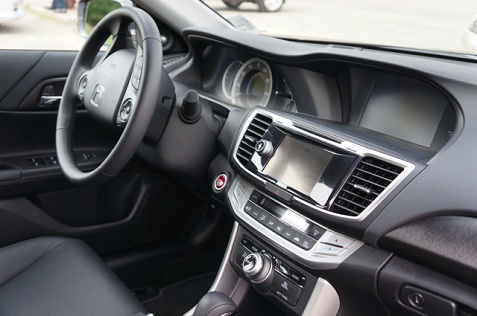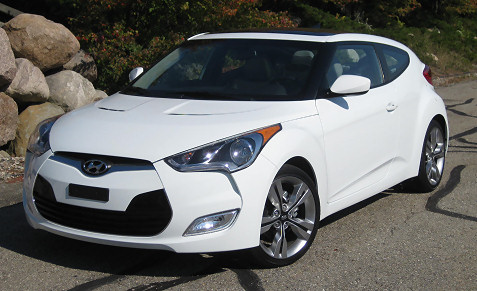First Drive: 2013 Honda Accord
The Accord has always been an important vehicle to Honda. The Accord accounts for a huge chunk of production (and revenue) for the automotive giant. Because of this every introduction of a new generation of Accord is important in many ways.
2011 was a rough year for Japanese automakers in general. The Japan earthquake and the flood in Thailand seriously curtailed the number of vehicles produced for the model year. Suppliers had to rebuild, Honda scrambled to find alternative sources of parts and supplies.
Honda used this time to prepare for a ramp-up of output in the first quarter of the new year. Inventory increased 46,000 units and hasn’t looked back ever since. Accord sales alone are up nearly 28% since January, a huge turn-around from 2011.
The 2013 Accord represents the ninth generation of the famous brand, with its ancestry dating back to 1976. The Accord has a reputation for being a solid and reliable family car, able to haul a family and their gear throughout their day-to-day adventures. The sedan excels at fading into the background; becoming ubiquitous and unassuming. Not a bad thing for a people-hauler.
Lineup
The Accord comes in three body styles: the Sedan, the Coupe, and the Plug-in Hybrid Sedan. Each is based off the same chassis and shares a majority of components. The continuation of the Coupe is a bit of a surprise given that the segment seems to be shrinking.
There are a variety of engines available that also define the offerings. The base four-cylinder 2.4 liter i-VTEC DOHC engine is available in both the Coupe and the Sedan, while the more powerful 3.5 liter six-cylinder is an option. The Hybrid Accord comes equipped with a two-motor 2.0 liter powerplant, unique to that vehicle.
Interior
Honda has focused on designing their vehicles around the concept of maximizing space for the occupants while minimizing the overall size of the vehicle. To that end the car is developed from the inside out: the passenger cabin space is defined and the designers must create a body that fits around the occupants.
To that end the 2013 Accord Coupe, for example, has been shrunk by nearly two inches in overall length, while gaining about an inch of leg room and almost two cubic-feet of storage in the trunk.
Improved Materials
The interior of the new Accord is a great improvement over the outgoing model. Utilitarian plastic and vinyl have been replaced with higher quality materials. Brushed aluminum accent pieces on higher-end trim levels add to the feeling of an upscale vehicle.
Honda has replaced the multi-piece dash with a one-piece instrument panel designed in-house. The new dash reduces rattles and squeaks and feels very solid. The dash is the focus of the new car, with a split two-screen control system acting as navigation and stereo controls.
Rear-view cameras are now standard across all versions, which is a big selling point for those of us who fear backing over an errant tricycle. It worked well, as the screen is mounted high and centrally located, making it a snap to use.
The navigation system seemed adequate, as did the stereo. Honda is rolling out it’s HondaLink system with the new Accord, which offers smartphone app support through device tethering. We didn’t get to test the system ourselves, but after seeing a demo of it I’m looking forward to getting a better look.
Also available is a Lane Departure Warning (LDW) system that alerts you when you drift slightly while driving. By slightly I do mean slightly, as the system kept triggering at the slightest provocation. Simply merging from an off ramp into traffic would sometimes cause it to chirp. Half-way through the test drive we were looking for a way to disable it.
Exterior
As mentioned earlier, the new Accord is slightly smaller than the out-going model. But the change isn’t noticeable. The lines of the car feel more defined, more aggressive. Honda used a new and improved stamping process for the new car and it shows in the presence the car exudes.
An important feature of the new car is the addition of an external rear-facing camera mounted on the passenger side mirror. This camera aids the driver by showing in the center display an image of what’s in the car’s right-side blind spot. Flip on the right turn signal and get a bird’s eye view of what’s in the way. In practice this is an incredible feature. During our test drive it became an easy thing to grow accustomed to. It’s a serious tool for highway driving.
Performance
The 2.4L four-cylinder engine puts out 185 horsepower and 181 foot-pounds of torque. It’s peppy, but not exceptional. As with most entry-level engines the focus is on fuel economy, not performance. Still, it has enough oomph to get out of it’s own way
The 3.5L six-cylinder’s output is up 7 horsepower from last year’s engine, up to 278. It gives the Accord a more spirited drive, and actually wakes up the vehicle. The engine note on the sixer is raspier and more aggressive; stomp on the gas and you’ll hear it. For my money this is the engine of choice.
Overall
Pricing for the Accord ranges from $22,000 for an Accord LX to $33,000 for a well-optioned Touring model. Quite a range, but within the pricing horizon of its competitors.
The Accord Sedan will go on sale September 19 across the country, while the Coupe, which will start at $23,350, won’t be available until October 15.
The first impression of the 2013 Accord is one of a competent and solid car. Honda is a company led by engineers, and it shows. The amount of effort that has gone into refining this icon is impressive. I look forward to driving it long-term to see if that first impression holds up over time.
You can follow us on Twitter and Facebook for content updates. Also, sign up for our email list for weekly updates and check us out on Google+ as well.
Posted in: Cars
Tags: auto photos, auto slideshow, auto tech, auto tech features, automobile gadgets, automobile photo gallery, autos, autos for guys, autos for men, car gadgets, car info for men, car photo gallery, car photos, car slideshow, car tech, car tech features, first drive, first drive automobile reviews, first drive car reviews, first drive reviews for guys, first drive reviews for men, honda, Honda Accord, Japanese cars, new automobiles, new autos, new cars









































